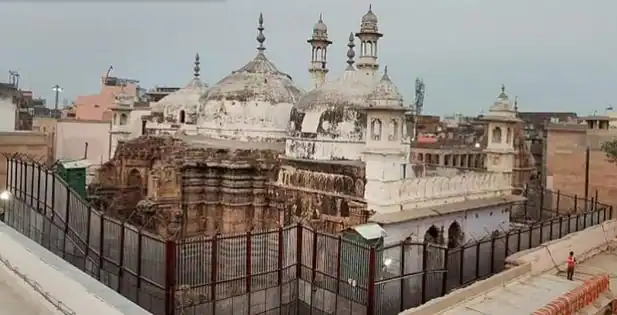Varanasi (Uttar Pradesh): The Varanasi civil court ordered to seal `wazukhana` in Gyanvapi mosque after “big Shivling” was found, said Lawyer Vishnu Shankar Jain, representing the Hindu side on Tuesday. Speaking to ANI, Jain said, “During the survey exercise yesterday, we found a well-like structure in the middle of the wazukhana. We requested the Commissioner to reduce the water level at the wazukhana. When the water was reduced, we reached the well-like structure and found a big Shivling. The Shivling has a diameter of around 4 metres and a height of around 3 feet. I believe it is deeper inside the ground.”
“It was necessary to put the fact under the knowledge of the court. We moved an application in the court seeking order to preserve and secure this important piece of evidence. Following this, the court ordered the CRPF commandants to protect it round-the-clock and UP DGP and Chief Secretary to monitor it,” he said.
The lawyer said the wuzu should not be performed there since Shivling was found there, adding “The area has been sealed. And, performing wuzu at the place of Shivling is not justified. So the court gave the order to seal the wazukhana area in the mosque.”
Asked about the claims by the other party that the structure is not Shivling but a fountain, Jain said, “We understand the difference between fountain and Shivling. If it is a fountain then it would have a different system. It is a Shivling.”
Notably, the Supreme Court will be hearing the plea seeking a stay on the survey of the Gyanvapi Mosque complex in Varanasi today.The SC bench, headed by Justice DY Chandrachud, will hear the plea of the Anjuman Intezamia Masajid Committee on Tuesday.
On this, Jain said, “I believe the matter in Supreme Court has gone infructuous. They (Muslim party) already complied the order they challenged in the Supreme Court. They participated in exercises and were part of the commission. Now can they challenge it after participating? We believe Supreme Court will not interfere in the matter.”
The three-day-long court-monitored videography survey of the Kashi Vishwanath Temple-Gyanvapi Mosque complex in Varanasi concluded on Monday. As the survey was completed, the Hindu petitioner in the case, Sohan Lal Arya on Monday claimed that the committee found a Shivling at the complex. Arya, who accompanied the court commission for the mosque survey, said that they have found “conclusive evidence”.
The survey was conducted in accordance with the Varanasi Civil Court`s order to continue the survey despite objections from the mosque authorities.
After the conclusion of the survey, the Varanasi court ordered the District Magistrate of Varanasi, Kaushal Raj Sharma, “to seal the area where the Shivling was found and to bar people from going to the place.”
In its order, the court said that the DM, police commissioner and the Central Reserve Police Force (CRPF) commandant Varanasi will be responsible for the security of the sealed area. The civil court had appointed a court commissioner to conduct the survey and videography of the site and the same was challenged before Allahabad High Court, which dismissed the appeal on April 21.
The April 21 order of the High Court was challenged in the apex court. Five women had filed a petition in the court seeking permission for daily worship at the Shringar Gauri temple, which is claimed to be situated inside the Gyanvapi Mosque premises.
The order of the civil court for undertaking survey and videography at the premises was subsequently given by the court. Another petition, which was filed by one Vijay Shankar Rastogi, had contended that the entire premises belonged to the Kashi Vishwanath Temple and that the Gyanvapi Mosque is only a part of the temple complex, is also pending in the court since 1991.
Rastogi had also claimed that the Kashi Vishwanath Temple had been built over two thousand years ago and the temple was demolished by the Mughal emperor Aurangzeb.
Advocate Vishal Singh, the Court-appointed special assistant commissioner, in Varanasi, said that the survey was conducted in an unhindered manner.






